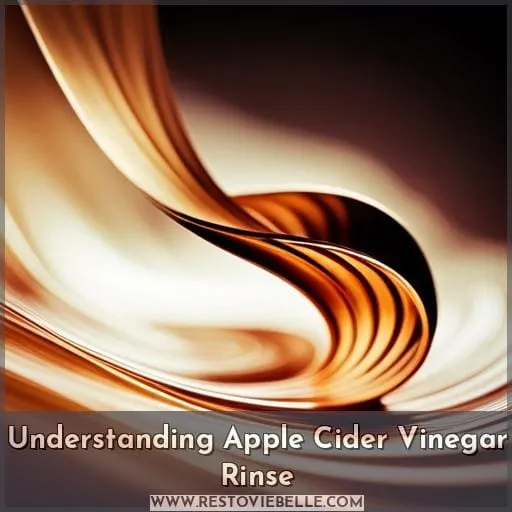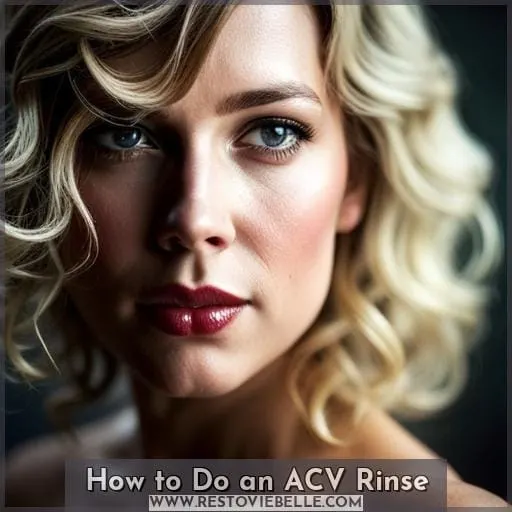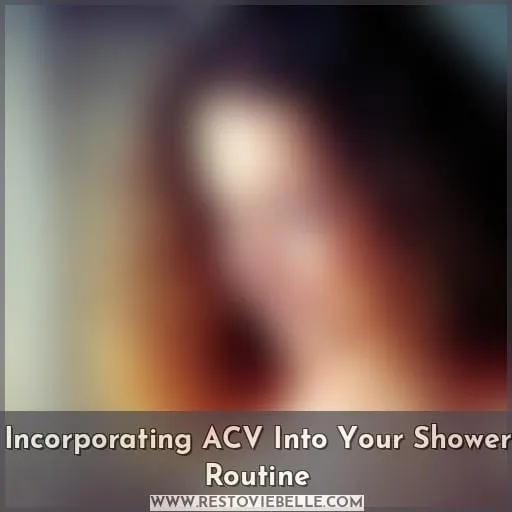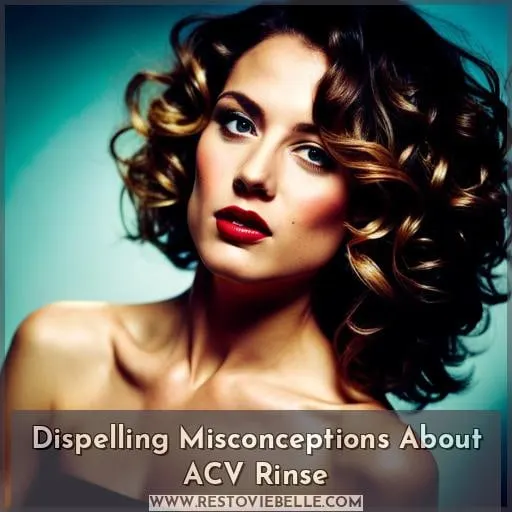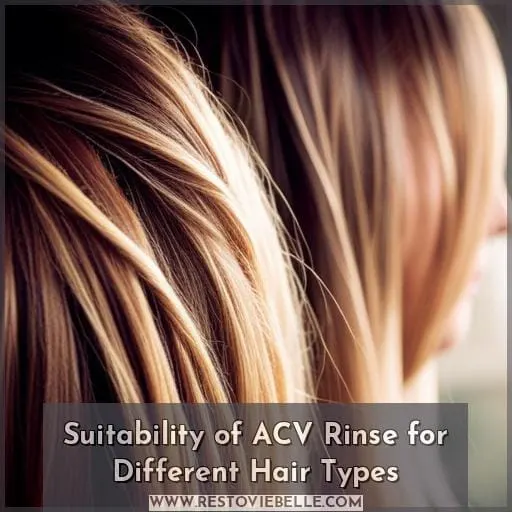This site is supported by our readers. We may earn a commission, at no cost to you, if you purchase through links.
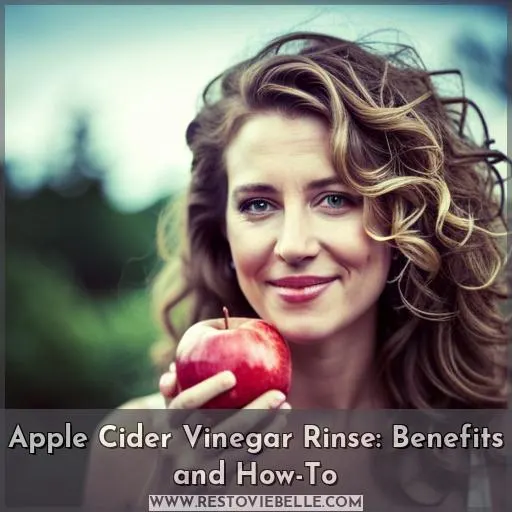 Imagine having luscious, bouncy curls without the frizz and damage. With an apple cider vinegar rinse, you can achieve just that. This powerful natural remedy has countless benefits for curly hair, from restoring pH balance to removing product buildup.
Imagine having luscious, bouncy curls without the frizz and damage. With an apple cider vinegar rinse, you can achieve just that. This powerful natural remedy has countless benefits for curly hair, from restoring pH balance to removing product buildup.
In this article, we’ll explore the benefits of apple cider vinegar rinse for your curly hair and guide you through the process step by step. Get ready to unlock healthier, more vibrant curls with this simple yet effective technique.
Table Of Contents
- Key Takeaways
- Understanding Apple Cider Vinegar Rinse
- How to Do an ACV Rinse
- Choosing the Right ACV
- Incorporating ACV Into Your Shower Routine
- Frequency and Results of ACV Rinses
- Dispelling Misconceptions About ACV Rinse
- Suitability of ACV Rinse for Different Hair Types
- Frequently Asked Questions (FAQs)
- Can I use regular vinegar instead of apple cider vinegar for the rinse?
- How long should I leave the ACV rinse in my hair before rinsing it out?
- Can I use ACV rinse on color-treated or chemically processed hair?
- Will ACV rinse make my hair smell like vinegar?
- Can I use ACV rinse if I have a sensitive scalp or skin allergies?
- Conclusion
Key Takeaways
- ACV rinse balances scalp pH, boosts moisture retention, and enhances hair health.
- It effectively removes product buildup and enhances natural curl definition.
- Use a dilution of 2 tablespoons of raw, unfiltered ACV in 16 oz of water and apply it to the scalp and hair for thorough coverage.
- Choose raw, unfiltered ACV with the mother, preferably organic, and prioritize sustainable and eco-friendly production methods.
Understanding Apple Cider Vinegar Rinse
Understanding Apple Cider Vinegar Rinse is crucial for reaping its benefits and avoiding potential risks. By exploring the benefits of ACV rinse for curly hair, such as pH balancing and scalp clarification, you can make an informed decision about incorporating it into your hair care routine.
Additionally, understanding proper dilution techniques and application methods will ensure safe usage and optimal results.
Benefits of ACV Rinse for Curly Hair
Curly hair enthusiasts, you’ll be delighted to know that an Apple Cider Vinegar (ACV) rinse offers a multitude of benefits for your gorgeous curls.
- Hydration Boost: ACV helps retain moisture in curly hair, preventing dryness and promoting softness and shine.
- pH Balance Insights: By balancing the pH levels of the scalp and hair, ACV reduces frizz and enhances curl definition.
- Curl Pattern Care: The clarifying properties of ACV remove product buildup without stripping natural oils, allowing your curls to thrive.
With these benefits in mind, incorporating an ACV rinse into your curly girl method routine can lead to beautifully defined curls with improved manageability!
Importance of Proper Usage and Caution
How can you ensure that you use apple cider vinegar rinse properly and with caution?
Proper application of apple cider vinegar rinse is essential to reap its benefits while minimizing any potential risks.
To begin, always dilute the ACV before using it on your hair to avoid excessive acidity that may harm your scalp.
Use a 16oz cup and add 2 tablespoons of ACV for effective dilution.
Choose a safe container like stainless steel or plastic, fill the cup with water in the shower just before use, and pour one-third of the mixture over your scalp while avoiding contact with your eyes.
Dip the ends of your hair into the remaining solution alternately for thorough coverage.
How to Do an ACV Rinse
To safely and effectively do an ACV rinse for your curly hair, it’s essential to follow proper dilution techniques.
- Dilute 2 tablespoons of raw ACV in a 16oz cup with water before application.
- Additionally, consider different application methods based on your hair length to ensure thorough coverage and even distribution of the mixture.
Dilution Techniques for Safe Application
To safely apply an apple cider vinegar rinse, start by diluting the ACV with water.
Safe dilution ensures that the acidity of the vinegar isn’t too strong for your scalp and hair.
Use a 16oz cup and add 2 tablespoons of ACV to effectively dilute it.
Choose a safe container, such as stainless steel or plastic, to avoid breakage in the shower.
Fill the cup with water just before use for optimal timing and application convenience.
By following these proper dilution techniques, you can ensure safe application of your apple cider vinegar rinse for effective hair care benefits without any harsh effects on your scalp or hair strands.
Application Methods for Different Hair Lengths
When applying an ACV rinse to your curly hair, it’s important to consider the different methods based on your specific hair length.
For shorter lengths, you can:
- Pour 1/3 of the ACV mixture over your scalp.
- Dip the ends of your hair into the cup for even distribution.
Longer lengths may benefit from using a dispenser bottle for more controlled application at the scalp.
Regardless of length, don’t forget to experiment with different techniques like:
- Gentle scalp massage.
- Adjusting quantities for thorough coverage.
After rinsing out with cool water, you can enjoy healthier curls without worrying about any lingering vinegar scent.
Choosing the Right ACV
When choosing the right ACV for your apple cider vinegar rinse, it’s important to consider factors such as quality and organic options.
- Opting for raw, unfiltered ACV with the mother ensures maximum benefits and nutrients for your hair.
- Look for affordable options that are readily available at grocery stores in a 32oz bottle size.
Factors to Consider When Selecting ACV
When selecting ACV for your apple cider vinegar rinse, it’s important to consider a few key factors:
- Vinegar Varieties: There are different types of vinegar available, such as white vinegar and rice vinegar. However, for an effective ACV rinse, it’s crucial to choose organic and raw apple cider vinegar.
- Fermentation Facts: Look for ACV that has undergone natural fermentation processes. This ensures the presence of beneficial enzymes and probiotics that contribute to its health benefits.
- Acidity Levels and pH Balance: Opt for ACV with a balanced acidity level around 5-6%. This helps maintain the optimal pH balance of your hair and scalp while avoiding excessive acidity that can cause irritation or damage.
By considering these factors when selecting your ACV, you can ensure you’re using a high-quality product with the right nutrient profile to promote healthy hair and scalp while maintaining proper pH balance.
Importance of Quality and Organic ACV
Choosing the right ACV is crucial for ensuring the effectiveness and safety of your apple cider vinegar rinse.
When selecting ACV, it’s important to prioritize organic sourcing, sustainable production methods, and health certifications. Look for unfiltered ACV with the mother intact as this contains beneficial enzymes and bacteria that promote scalp health.
Additionally, consider factors such as nutrient preservation and acidity balance in your choice of ACV.
To help you make an informed decision when purchasing ACV for your rinse, here are some key considerations:
| Factors | Recommendations |
|---|---|
| Organic Sourcing | Opt for organic-certified products |
| Nutrient Preservation | Choose unprocessed or raw varieties |
| Acidity Balance | Look for a pH level between 4-5 |
| Sustainable Production | Support brands committed to eco-friendly practices |
By prioritizing quality and organic sourcing in your choice of Apple Cider Vinegar (ACV), you can ensure that you’re using a product that maximizes its benefits while also being environmentally conscious.
Incorporating ACV Into Your Shower Routine
Now that you have chosen the right ACV and learned how to dilute it properly, it’s time to incorporate ACV into your shower routine for maximum results.
The ideal timing for an ACV rinse is after shampooing and conditioning with a normal rinse-out conditioner. You can experiment with variations in your routine, such as skipping conditioner or deep conditioning, but always make sure to thoroughly rinse out the mixture before applying any styling products.
Ideal Timing for ACV Rinse
Now let’s dive into when is the ideal time to incorporate an ACV rinse into your shower routine.
The timing of your ACV rinse depends on various factors such as personal preference and desired results.
You can choose to do it in the morning or at night, depending on what works best for you.
If you prefer pre-styling treatments, then doing an ACV rinse before styling can help balance the pH level of your hair and remove any build-up that may hinder styling products from working effectively.
Additionally, incorporating seasonal usage of ACV rinses can help maintain scalp health throughout different weather conditions.
Lastly, consider doing a post-coloring ACV rinse to restore the hair’s pH balance after chemical treatments like dyeing or bleaching.
Remember that integrating an apple cider vinegar rinse into your shower routine isn’t only about timing but also about reaping its benefits for healthy and vibrant hair.
Recommendations for Maximizing Results
To maximize the benefits of your ACV rinse, incorporate it into your shower routine after shampooing and conditioning for optimal results.
Here are some recommendations to help you get the most out of your ACV rinse:
- Try different ingredient combinations by adding essential oils like rosemary or lavender for added benefits.
- Experiment with timing variations by leaving the ACV mixture on your hair and scalp for a few minutes before rinsing.
- Enhance the effectiveness of your ACV rinse by incorporating a scalp massage during application to stimulate blood circulation.
Frequency and Results of ACV Rinses
When it comes to the frequency of ACV rinses for curly hair, aim for 4-6 times a year to avoid overuse.
Use an ACV rinse when your hair feels unexpectedly frizzy or different from usual as it acts as a clarifying treatment, resetting your wavy/curly hair for new seasons.
However, be cautious not to overdo it as excessive use can lead to dull and dry hair.
Adjust the frequency based on the results you observe and remember that if ACV doesn’t suit your hair, it can still be used in cooking!
Guidelines for Frequency of ACV Rinses
To achieve optimal results, it’s important to consider the frequency of your ACV rinses.
Finding the right balance between maintaining scalp health and hair resilience is key. Frequency management can help maintain pH balance and make seasonal adjustments as needed.
It’s recommended to aim for an ACV rinse frequency of 4-6 times a year to avoid overuse.
Use ACV when your hair feels unexpectedly frizzy or different from usual, as it acts as a clarifying treatment that resets wavy/curly hair for new seasons.
Adjusting the frequency based on results is crucial in ensuring healthy hair maintenance and clarifying scalp benefits.
| Frequency Management | Scalp Health |
|---|---|
| Aim for 4-6 times/year | Maintain pH Balance |
| Adjust according to frizz or change in feel | Clarify scalp |
Table: Guidelines for Frequency of ACV Rinses
Understanding the Expected Results and Adjustments Needed
To understand the expected results and make necessary adjustments, you’ll need to determine the frequency of ACV rinses that works best for your hair.
- Reduction in frizz: ACV helps smoothen frizzy curls.
- Balanced pH level: It restores optimal pH balance for healthy hair.
- Clarified scalp: ACV exfoliates and removes buildup from the scalp.
- Improved curl definition: It enhances natural curl pattern.
-
Adjustment tips:
- Start with a monthly rinse and observe how your hair responds.
- Increase or decrease frequency based on desired results.
-
Result interpretation:
- If your curls become too dry, reduce frequency or dilute further.
- If there’s minimal improvement, consider using a clarifying shampoo before an ACV rinse.
-
Effectiveness insights:
- Low porosity hair may require less frequent rinses due to slower product absorption
and potential buildup issues.
- Low porosity hair may require less frequent rinses due to slower product absorption
Dispelling Misconceptions About ACV Rinse
Let’s clear up some common misconceptions about ACV rinse to ensure you have accurate information for informed usage. By dispelling these myths, we can provide a better understanding of the benefits and proper application of apple cider vinegar rinse for curly hair.
It’s important to address concerns such as acidity, scent, and potential damage in order to promote safe and effective use of this natural remedy.
Addressing Common Misconceptions About ACV Rinse
Let’s clear up some common misconceptions about ACV rinse and provide accurate information for informed usage.
One misconception is that ACV rinse is too acidic and can harm the scalp. However, when properly diluted, ACV has a safe pH level for use on hair.
Another myth is that it leaves a strong vinegar scent after rinsing thoroughly, but this isn’t true if you dilute it correctly and follow proper application techniques.
Additionally, there are myths surrounding its effectiveness in clarifying the scalp or closing the hair cuticle, but these benefits can be achieved with regular use of ACV rinse.
Providing Accurate Information for Informed Usage
Don’t let misconceptions cloud your understanding of Apple Cider Vinegar (ACV) rinse – get the facts straight for informed usage.
It’s important to address some common misconceptions about ACV rinse to ensure accurate information and safe application.
First, it’s crucial to understand ingredient compatibility and scalp sensitivity when using ACV rinse.
Additionally, maintaining pH balance is key for healthy hair, as well as considering hair porosity when determining dilution techniques.
By dispelling these misconceptions and providing accurate information on ingredient compatibility, scalp sensitivity, pH balance, hair porosity, and dilution techniques , you can confidently incorporate ACV rinses into your curly hair care routine while reaping their many benefits.
Suitability of ACV Rinse for Different Hair Types
When it comes to the suitability of an ACV rinse for different hair types, it’s important to consider factors such as curl pattern and hair porosity.
While ACV rinse can benefit many individuals with curly or wavy hair, it may not be universally suitable for all.
Tailoring the dilution ratio and frequency of use based on your specific needs can help you achieve optimal results without causing any adverse effects.
Considerations for Different Hair Types
Now, let’s delve into how the suitability of an ACV rinse varies for different hair types.
When considering the use of an apple cider vinegar rinse, it’s important to take into account factors such as:
- Porosity impact
- Texture variations
- Moisture balance
- Scalp sensitivity
- Curl definition
Different hair types have unique needs and characteristics that should be considered when incorporating ACV rinses into their routine. For example, high porosity hair can benefit from ACV’s cuticle-closing properties while those with sensitive scalps may need to dilute the solution further or avoid using it altogether.
Understanding your specific hair type will help you customize your ACV rinse for optimal results in terms of overall health and appearance.
Customizing ACV Rinse for Optimal Results
To customize your ACV rinse for optimal results, it’s important to consider the specific needs of your hair type.
Different hair types require different ingredient variations and personalized formulas to achieve the best outcomes. Take into account factors such as scalp sensitivity, dilution ratios, hydration balance, and the desired effect on scalp health and hair cuticle closure.
Experiment with varying amounts of ACV in your mixture, while also incorporating products like silicone-free conditioner or clarifying shampoo to enhance the benefits of the rinse.
By tailoring your ACV rinse specifically for your hair type, you can maximize its effectiveness in achieving healthy and vibrant locks.
Frequently Asked Questions (FAQs)
Can I use regular vinegar instead of apple cider vinegar for the rinse?
Using regular vinegar instead of apple cider vinegar for the rinse isn’t recommended.
Apple cider vinegar has unique properties and a more beneficial composition for hair health.
Stick to using apple cider vinegar for optimal results.
How long should I leave the ACV rinse in my hair before rinsing it out?
To achieve optimal results, leave the ACV rinse in your hair for 1-3 minutes before rinsing it out. This allows enough time for the vinegar to work its magic and impart its beneficial properties onto your locks.
Can I use ACV rinse on color-treated or chemically processed hair?
Yes, you can use an ACV rinse on color-treated or chemically processed hair. However, be cautious as it may cause slight fading over time. It’s recommended to do a patch test and monitor the results for personalized assessment.
Will ACV rinse make my hair smell like vinegar?
No, when used correctly and thoroughly rinsed out, an apple cider vinegar rinse won’t leave a lingering vinegar scent in your hair.
Can I use ACV rinse if I have a sensitive scalp or skin allergies?
If you have a sensitive scalp or skin allergies, it’s recommended to proceed with caution when using an ACV rinse. It’s like walking on thin ice; test a small area first and monitor your reaction before committing to the treatment.
Conclusion
To achieve healthier, more vibrant curls, incorporating an apple cider vinegar rinse into your hair care routine is a game-changer. This natural remedy offers numerous benefits for curly hair, from restoring pH balance to removing product buildup.
By following the proper dilution techniques and application methods, you can safely and effectively use apple cider vinegar rinse for your specific hair length and type. So say goodbye to frizz and damage and say hello to luscious, bouncy curls with the power of apple cider vinegar rinse.
